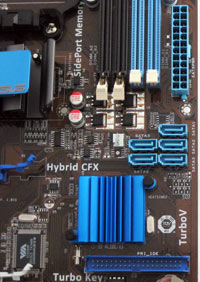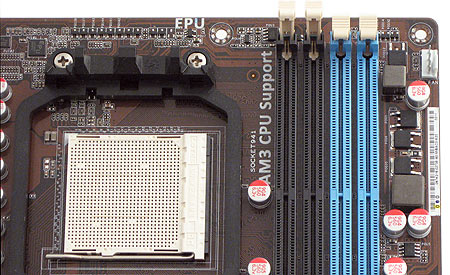Seven AMD 785G-Based Motherboards Rounded Up
Asus M4A785TD-V EVO: Features And Hardware
Next, we'll have a look at Asus' entry into our roundup, the M4A785TD-V EVO. This is the ATX counterpart to the microATX M4A785TD-M EVO motherboard we used in our 785G launch article. This version is to be taken seriously by power users, with 140W CPU support, 1,800 MHz overclocking DDR3 support (the highest claimed memory speed in our roundup), 128MB of SidePort on-board memory, and a 10-phase voltage regulator (twice as many power phases as any other 785G board in our roundup). This board sports ASUS' Xtreme Design designation which includes a higher standard of EMI protection, 2 oz. of copper in the PCB for better thermal dissipation, multiple power phases, and the Turbo overclocking tools.
The bundle is fairly standard, and includes an IDE cable, four SATA cables, an I/O shield, a manual, and a driver CD. But it also comes with a removable system panel and USB connectors for ease of installation.
Other features include Turbo Key (allows the power button to function as an overclocking button), Turbo V (Asus' software overclocking tool that allows BIOS-level control within the OS), GPU NOS (Asus' automatic graphics overclocking system that detects the state of the graphics card in hardware and overclocks accordingly), and Express Gate (a light instant-on Linux distribution that features a Web browser, photo access, Flash games, instant messengers, and Skype; it features a five second boot up time).
We were a little disappointed to see that the board didn't have some of the more common enthusiast-class features, such as on-board power, reset, or clear CMOS buttons.
The two PCIe x16 slots ensure dual-card CrossFire compatibility. [edit: The blue PCIe slot offers full 16x bandwidth, while the grey slot is limited to 4x bandwidth. This will likely have a negative effect on CrossFire performance compared to two 16x or even two 8x slots]
For the most part, the board is well laid out. The 24-pin ATX power cable is in an ideal central location, easily reached by standard ATX power supplies. The five SATA ports are also central, and point directly out of the board instead of to the right. Potential interference with long graphics cards is avoided by placing them all above the first x16 PCIe slot.
Our few complaints in this department include the IDE port, which is run perpendicular to the side of the board. The most irritating drawback is a CPU fan plug that seems unnecessarily far from the CPU at the very top right of the board, and is positioned so that the memory modules lie between the CPU fan connector and the fan.
Get Tom's Hardware's best news and in-depth reviews, straight to your inbox.
Current page: Asus M4A785TD-V EVO: Features And Hardware
Prev Page ASRock M3A785GXH/128M: BIOS And Overclocking Next Page Asus M4A785TD-V EVO: BIOS And OverclockingDon Woligroski was a former senior hardware editor for Tom's Hardware. He has covered a wide range of PC hardware topics, including CPUs, GPUs, system building, and emerging technologies.
-
JohnnyLucky Very informative article. Nice to see there are motherboards with different features for different users/tasks.Reply -
bpdski Great article, I think this shows pretty conclusively that there is no benefit to upgrading to an AM3 based system. If you already have an AM2+ system, you can easily just drop in a new CPU and you system will be every bit as good as a brand new system with DDR3. You just need to make sure your motherboard supports the power requirements of whatever you want to drop in.Reply -
jonpaul37 Hooray AMD for having cheap solutions in these hard-economic times!Reply
Boo @ Intel! i like the product, but my wallet & Girl do not like the cost! -
jonpaul37Hooray AMD for having cheap solutions in these hard-economic times!Boo @ Intel! i like the product, but my wallet & Girl do not like the cost!+1Reply
Girl has more money for clothes! -
ominous prime Well bpdski there is no point upgrading if you're AM2, but if you're building a new PC AM3 is the way to go in terms of your computers longevity. Very informative article.Reply -
sonofliberty08 thanks alot for the info , my first choice was allways asus , but now i now what i need when im going to unlock core , and now i saw the benefits of sideport memory .Reply -
duzcizgi ReplyWe were successful in achieving a 900 MHz stable overclock with the integrated graphics chipset by setting the BIOS to increase northbridge voltage by +.210mV.
Well, .210 mV = 210 microvolt. I don't think it would make much of a change. Maybe it is 210 mV or, .210 V. :) -
doron "Now we're seeing another benefit for the AM2+/DDR2 boards: both the Foxconn Cinema Premium and Biostar TA785GE 128M are drawing less power than their AM3/DDR3 counterparts."Reply
How comes? Didn't we all agree a long time ago that ddr3 supposed to be more energy efficient out of the two? (Lower voltage and stuff?) -
DarkMantle Great article, this will help a lot of people to make their AMD budget motherboard choice easier, thank you Don.Reply



